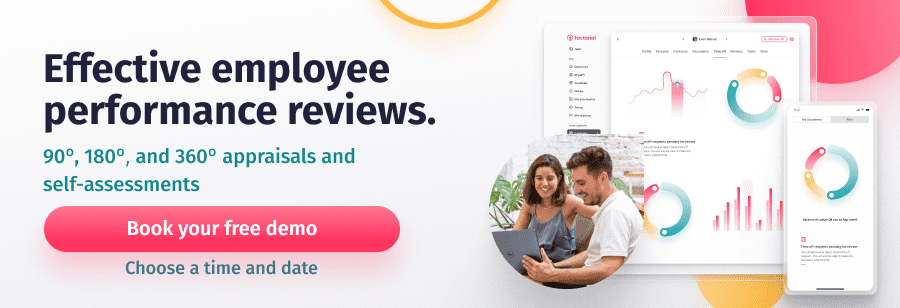Continuous performance management is a set of processes that track and evaluate an employee’s productivity in line with the objectives of a company. The aim is to identify areas of improvement and encourage employees to continuously develop their skills. It is a vital tool used by HR departments that can help build a culture of trust and open dialogue as well as improve employee engagement.
In this post, we will look at the differences between continuous and traditional performance management systems. We will explain why continuous management can benefit your company and how you can implement it in your company. Finally, tips will be shared on the best practices to help you design an effective performance management strategy for the good of your employees and your company as a whole.
What Is Continuous Performance Management?
Continuous performance management (CPM) is an HR tool for tracking, evaluating, and improving employee performance. It is based on the principles of continuous analysis, agile management and real-time feedback. It involves setting standards and expectations for performance and guiding employees to help them meet their goals. Employees are then monitored regularly and assessed against their performance standards and goals. This helps companies identify and address any issues with poor performance.
The most important aspect of CPM is maintaining regular reviews and appraisals. This creates a culture of open two-way dialogue (not just top-down evaluation) and encourages employees to take responsibility for their own professional development. This, in turn, builds trust within the company, creates stronger relationships between managers and employees, and helps employees realise their true potential for the good of the business. Companies that implement a CPM strategy find that it increases employee engagement and performance, and improves communication and retention levels.
Traditional Performance Management
Performance management is not a new concept. In fact, it could arguably be traced right back to the Egyptians and their use of whips to encourage increased performance. Thankfully things have moved on a bit since then. More traditional performance management systems can be traced back to the start of the Industrial Revolution in the late 1800s. During this period, employees were viewed as “workers” and their output was easy to measure: hours worked, goods produced, etc. The focus was very much on what an employee had produced, rather than what they were capable of.
This perspective began to shift in the 1960s when a more holistic approach was adopted. This new method had a greater focus on self-appraisal and was more concerned with what an employee could achieve in the future with the right support and development. From this point on, traditional performance management typically involved self-evaluation, manager evaluation, scoring and annual appraisals. But appraisals were still very much tied in with bonuses and promotions (such as performance-related pay) rather than individual performance and the impact it had on a company’s goals.

Issues with Performance Management
Although traditional performance management systems were a step forward, many companies these days find them to be lacking. For one thing, trying to compress a year’s worth of performance into an annual appraisal is time-consuming. Especially when you consider that you need to do this for each of your employees. It makes far more sense to focus on continuous evaluation throughout the year and assess goal progress on a regular basis.
Other disadvantages of performance management systems used in the past include stress and pressure. With an annual review, an employee feels they only have one opportunity each year to raise any concerns relating to their job, development and working environment. And if you want your employees to improve their performance then they need regular feedback so that they know what areas they need to work on. A lack of clear goals and expectations and rating inconsistencies can also have a negative impact on employee performance.
Benefits of Continuous Performance Management
- As an employer, you get a clear overview of how each employee in your company is performing. Are they delivering as expected? How could they improve?
- Continuous performance management doesn’t rely on top-down input like the traditional employee appraisals system. Instead, you collect feedback from all directions, including peer and 360-degree performance reviews. This gives you a fuller picture of how every cog in the company is performing.
- Continuous performance monitoring establishes open channels of communication and transparent dialogue. This helps to build trust in your company.
- You get better quality key performance indicator (KPI) data as you are gathering information from numerous sources (conversations, check-ins, progress updates, peer reviews, etc.). This also helps to reduce prejudice and discrimination.
- When you send your employees regular surveys they feel that their voice is important. This helps them feel supported as they know they have a channel to air any concerns or grievances. It improves communication, strengthens employer-employee relations, and boosts engagement and retention.
- Rather than overloading your HR department with the burden of annual appraisals, you can gather your data consistently throughout the year. Not only does this reduce your workload, but it also provides you with real-time data on all your employees. You also have access to more key data for each employee so you know exactly what needs to be discussed when you hold their appraisal meeting.
How to Implement CPM in Your Company
The traditional performance management philosophy was based on the belief that organisations operate in stable environments. COVID-19 (as well as general shifts in globalisation and technology) has demonstrated that in reality, our environments are anything but stable. As we adapt to changes in the way we work we will need to rethink how we approach performance reviews and accountability.
Performance management starts with good leadership. Train your senior managers so that they are aware of the benefits of continuously tracking employee performance. Promote a culture of communication and individual accountability and inspire employees to strive for professional development. Make sure you revisit and adapt goals on a regular basis.
Finally, make sure you have the right tools and technology so that you can get the most from your performance management data. Performance management software can help you track employee performance and appraisals. It can also help you schedule meetings and surveys and collect 360-degree feedback so that you always have access to real-time data.
✅Download Factorial’s Free 360-degree Performance Review Template
What Defines an Effective CPM Strategy?
An effective continuous performance management strategy focuses on leadership, communication, interpersonal relationships, constructive feedback, and teamwork. You need to base your strategy on a foundation of mutual trust and recognition. You also need to make sure that the policies and procedures you define support the goals of your company. The same goes for the tools and technology you decide to use.
If you are considering implementing a continuous performance management strategy in your company, then there are a number of best practices to keep in mind. Firstly, you need to ensure you implement processes for managing all four stages of the performance management cycle:
- PLAN (set and agree on goals with an employee)
- ACT (achieve objectives)
- MONITOR (measure progress, offer training and feedback)
- REVIEW (achievements, lessons learnt and next steps)
Factorial's Performance Management Software
Factorial’s performance management software can help your employees set goals in line with the objectives of your company. The handy performance dashboard provides a comprehensive view of all feedback, annual summaries, regular check-ins, and established goals. You can also use the software to schedule employee appraisals and collect regular feedback. This will give you access to valuable real-time data when you need it the most. And with our powerful analytics you can truly understand how each employee is performing and developing and the impact they are having on the success of your business.


